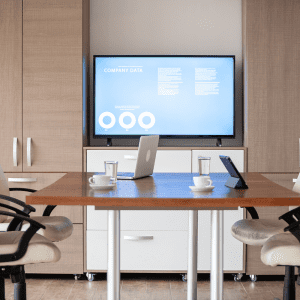In today’s hybrid work setups, USB connectivity is no longer just about keyboards and flash drives. It powers webcams, speakerphones, interactive displays, PTZ cameras, and even touch control panels. But there’s a catch: USB has distance limitations.
That’s where USB extenders come in.
Let’s break down what they do, who needs them, and when they become essential to your AV infrastructure.
🧰What Is a USB Extender?
A USB extender allows you to extend USB connections well beyond the standard 5-meter (16-foot) limit, often up to 100 meters or more, using Cat5e/Cat6 cabling or fiber.
Instead of plugging your USB camera or device directly into a PC or codec, you plug it into the remote unit, and then run a single network cable to a host-side unit at the other end.
Works with:
- USB 2.0 and USB 3.0 devices
- Audio and video conferencing gear
- Touch-enabled displays and panels
- KVM (keyboard-video-mouse) setups
Who Needs a USB Extender?
USB extenders are especially useful in corporate and hybrid work environments where tech and people are spread out across rooms and roles. You likely need one if:
- Your webcam or speakerphone is more than 5m away from the PC
- You’re using a touch display in a huddle space, and the compute unit is mounted behind a wall or ceiling
- You’re running PTZ cameras across large boardrooms or training areas
- You want to hide PCs inside AV racks or secure enclosures
- You need to maintain USB signal integrity over long distances
Real-World Use Cases
1. Meeting Rooms with Ceiling-Mounted Mics and Cameras
If you’ve got USB conferencing devices mounted on ceilings or walls, USB extenders let you connect them to the in-room PC without signal drop or noise.
2. Touch Panels for Room Control or Scheduling
Many touch control panels use USB for communication. When the main system is tucked inside an AV rack, extenders keep the connection stable over long cable runs.
3. Training Rooms and Auditoriums
In larger spaces, presenters may connect via USB at a podium while the main PC is far away. USB extenders bridge that distance while keeping user experience plug-and-play.
4. Hot-Desking or Flex Desking Environments
USB extenders can allow a universal dock or hub to serve multiple desks or zones across an open-plan office without having to relocate hardware every time.
How to Choose the Right USB Extender
Here’s what to consider:
| Feature | What to Look For |
|---|---|
| Distance | 10m, 50m, or up to 100m depending on layout |
| USB Version | USB 2.0 for AV, USB 3.0 for high-speed needs |
| Cable Type | Cat6, Cat6A, or Fiber for longer runs |
| Power Options | Local power or PoE-based options |
| Compatibility | Works with Zoom Rooms, Teams Rooms, etc. |
Some USB extenders are also part of AV-over-IP ecosystems, which means you can route multiple signals over your network with switching capabilities.
When to Install USB Extenders
Install extenders during:
- New conference room builds
- AV refresh projects
- Moving to a BYOD or room-based UC setup
- Centralizing IT or AV hardware in secure spaces
Bonus: many modern extenders are plug-and-play, no drivers or software needed—perfect for keeping IT overhead low.
Final Takeaway
If your AV setup includes USB-connected devices spread across a room or if you’re planning for scalable hybrid work infrastructure, a USB extender isn’t optional. It’s the difference between glitchy connections and rock-solid performance.
At Nvictta, we help you design clean, efficient USB infrastructure tailored to hybrid workflows, meeting room standards, and future growth.
👉 Talk to Nvictta today for recommendations on USB extenders, cabling plans, and hybrid-ready AV gear.





